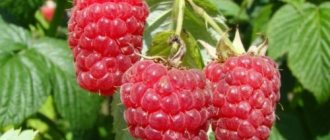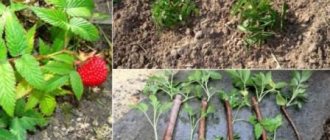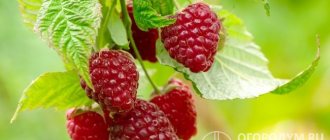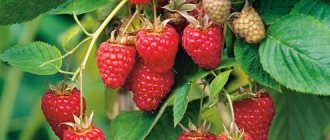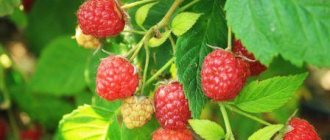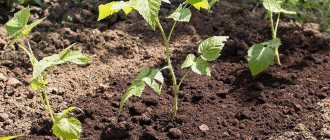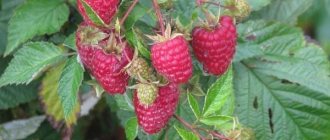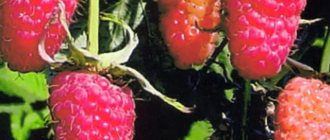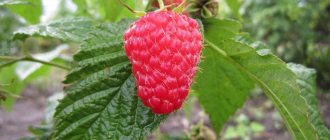Large-fruited raspberry varieties, bred by the famous Russian breeder V.V. Kichina, have a number of properties that are very attractive to gardeners. At the same time, these are controversial plants, extremely demanding on growing conditions and agricultural technology. Today we will talk about one of them - the “Beauty of Russia” raspberry.
According to reviews of domestic summer residents, the Krasa Rossii raspberry (pictured) not only has numerous advantages, but also has disadvantages characteristic of most “Kichinovo” varieties
Let's look at the most significant features of the variety in the table:
| Parameter | Characteristic |
| Culture | Garden raspberry (Rubus idaeus L.) |
| Fruiting | One-time (non-repairable) |
| Ripening time | Average |
| Productivity | High: about 200 c/ha, on average 4-5 kg per bush (maximum - up to 8 kg) |
| Berries | Large (weighing from 4 to 12 g), conical, bright red, shiny, with small seeds |
| Pulp | Juicy, sweet, aromatic |
| Tasting assessment | 4.1-4.3 points (out of 5) |
| Purpose of berries | Dessert, suitable for all types of processing, freezing |
| Features of the plant | The bushes are medium-sized, compact, powerful. Stems are strong, without thorns. The leaves are large, dark green, wrinkled. Each fruit branch can produce more than 20 berries. |
| Shoot formation activity | Average |
| Sustainability | The variety is moderately winter-hardy, does not tolerate heat and drought; resistance to all major diseases and pests at the level of the best standard varieties |
| Cultivation technology | Requires intensive agricultural technology: constant watering and spraying of leaves with water (especially during drought), regular fertilizing; in regions with long frosty winters, shoots must be bent and covered |
| Registration in the Federal State Budgetary Institution "State Varietation Commission" | Turned off |
Description of raspberries Krasa Russia
The history of this non-repairing variety begins in 1990, when Professor V.V. Kichina crossed the Maroseyka and Mirage varieties to produce a new large-fruited raspberry bush. For its outstanding external data and excellent characteristics, the result of the crossing was called the Beauty of Russia.
Large, uniform Krasa Rossii raspberries are a real gift for any gardener
The bush reaches a height of 1.6 meters, that is, it is considered medium-sized. It is compact and does not take up much space in the garden. In one season, the plant grows a dozen new shoots and five root shoots. The stems are strong, with a small edge, but without thorns and with the effect of a light waxy coating. The fruiting branches are very strong and have many tendrils. On average, about two dozen berries ripen on each of them.
The leaves on the shoots are located along the entire length; they are large, embossed, dark green, with a slight shine. The flowers are very large.
The Krasa Rossii raspberry bush is medium-sized, but with strong shoots that can bear a large harvest
You might think that since there are large flowers on the bush, then the berries will be large. That’s right, they ripen medium and large – from 4 to 12 g. Most of the harvest is represented by weighty specimens. The berries are conical, homogeneous, have a pronounced sweet taste and are very aromatic.
A distinctive feature of the berries of this variety is their short shelf life - fresh raspberries after picking can last only a few hours. So it must either be consumed immediately or processed.
Krasa Rossii is a medium-ripening variety. Its fruiting period is extended - the number of harvests is from 4 to 5. On average, 4.5 kg of berries are obtained from one bush, and up to 19 tons per hectare.
Video about the variety
Advantages and disadvantages
The best thing about this variety is the wonderful taste of the berries and their aroma. This is why gardeners love raspberries so much. Add here the large size of the berries and you get an almost real raspberry dream.
Productivity is also at a high level - Krasa Rossii does not lag behind other large-fruited varieties (for example, Tarusa or Monomakh Caps).
The productivity of Krasa Rossii is one of its main advantages of the variety
The average ripening period of berries is a big plus of this variety. You can pick the first berries from the bush in early July, and mass ripening begins in the second half of the month. In this situation, the gardener will not have problems, as with remontant varieties, part of the harvest of which is lost after the first frost.
The advantages of the variety are drought resistance and frost resistance. Raspberries can withstand temperatures of -20...-25 °C well, and if there is a lot of snow in winter, then even up to -30...-35 °C. But every medal has a downside, and in summer the Beauty of Russia depends on weather conditions. During periods of high humidity, there is a high risk of the bush being damaged by brown spot and gray rot.
The berries of Krasa Rossii are large but tender; they must be picked carefully
Also, with insufficient care, the plant can be affected by such scourges as spotted mosaic and chlorosis. Despite this, the variety is considered resistant to most diseases typical of raspberries.
The poor keeping quality of berries is another reason for dissatisfaction. However, this factor does not cause any trouble if the raspberries are put into circulation right there, at the dacha. It’s another matter if you have a long trip to the city ahead. In terms of transportation, the variety performed well, but keeping quality must be taken into account.
Landing Features
Raspberries love the sun and cannot tolerate excess water. Based on these requirements, you should choose a well-lit place that is not blown by wind, so that the snow lingers in winter. Groundwater should not be closer than 1.5–2 meters to the surface. Medium loams without a high degree of soil fat are very good for planting, so that the plant does not vegetate too much.
Planting can be done both in spring (April - May) and autumn (September - October). Sometimes raspberries of this variety are planted in August.
Planting raspberries in trenches is the most convenient way
You need to choose high-quality planting material - with a well-developed root system and strong shoots. If several plants are planted at the same time, maintain a distance of one meter between them. The best scheme for planting raspberries is in rows, leaving a distance of 1.5–2 meters between them. It is thanks to this planting that you will be able to control the degree of thickening of the bushes (and the Beauty of Russia does not like strong thickening) and give the harvest the opportunity to fully ripen.
Neat rows of raspberries make raspberry bushes easier to care for and harvest
The trench method of planting raspberries is considered optimal. Based on the meter distance between the bushes and the number of seedlings, think in advance about how many rows you will make. After all, trenches are dug three to four weeks before planting.
- The trench width is 50–60 cm, and the depth is 40–45 cm.
- A ten-centimeter layer of rotted manure or compost is laid at the bottom to provide high-quality nutrition for the seedlings.
- Double superphosphate (about 15 g) can be sprinkled on top with an even thin layer. Vermicompost is poured on top of it. The layer should be at least 2–3 cm deep so that the roots of the seedlings do not have direct contact with the mineral fertilizer.
- The top fertile layer of soil will serve to fill the trench when planting plants. You can add a little ash to it - it will improve the taste of the berries in the future.
- The seedlings are placed in a trench and covered with earth.
- In order to retain moisture in the soil longer, the bed is mulched with peat or rotted grass.
It is not recommended to apply nitrogen-containing fertilizers when planting raspberries, so as not to interfere with rooting and not to disrupt the process of preparing for winter if this happens in the fall.
In addition to planting seedlings, raspberries are also propagated using root shoots. Green offspring are usually selected in late May - early June, when they reach a length of 15–20 cm. Hot and dry weather only contributes to their appearance. Only those offspring that have actively growing young white roots should be selected for planting. If the shoot is too long, it is shortened to the specified length. This should not affect the quality of the planting material, because we only need a root collar with roots and a few leaves.
Propagation by root shoots saves time and money, but requires increased care
Spring planting of raspberries has no advantages over autumn planting. Raspberries planted in spring can take quite a long time to take root and often produce replacement shoots. As for autumn, it is recommended to plant mature plants on which replacement buds are clearly visible.
Selection of seedlings and planting methods
Before you buy a plant, you need to carefully study the condition of its root system. If it is rotten, then the seedling is left, if it is well developed, then the planting material can be taken. Shoots must be free of diseases and third-party branches. Before purchasing, read all the characteristics and description of the variety so as not to make a mistake with your choice.
Some gardeners plant berries in the spring. But this does not guarantee complete rooting of the plant from the first year. To achieve a reliable result, the procedure is scheduled for the autumn period, at which time it is more painless.
Raspberries can be planted not only with ready-made seedlings in open ground, but also with the help of root shoots. This is done like this: at the end of May, the most tenacious shoots, the height of which exceeds 20 cm, are determined and planted in a nutrient substrate. Cuttings are rooted in any weather conditions: both during rain and during drought, but dry, sunny weather is more beneficial.
Plant care
Raspberry Krasa Rossii is quite demanding in terms of growing conditions, and neglecting the rules for caring for it can lead, at best, to a decrease in yield.
Formation
We should start with the fact that this variety really does not like thickening. This deteriorates the plant’s protective functions and disease resistance. To prevent this, proper pruning is required. In the first year, a raspberry bush should have 6-7 of the strongest shoots, which also need to be tied up.
Scheme of formation of raspberries on a trellis
A trellis is the best option, which you can start using when the plant reaches a height of 80 cm. Raspberries growing on trellises are well illuminated by the sun and are better ventilated. In addition, a tied plant does not break in strong winds and during the period of abundant fruiting. The lower branches especially need garter, otherwise proximity to the ground, especially during periods of high humidity, can provoke the appearance of fungal diseases. And as a pleasant bonus, harvesting from tied bushes is much easier and more enjoyable.
Many gardeners show pity for raspberries and do not touch them after planting. However, if you shorten a freshly planted plant to a height of 20-25 cm, you will increase its survival rate and increase the chances of a rich harvest in the future. Remember, raspberries develop very quickly, and such pruning will not harm it; on the contrary, it will only benefit it.
In the second year, after the buds open, only the strongest and healthiest shoots are left. The rest are cut almost to the ground. 10–12 shoots are left per meter. Annual stems that are left for fruiting are cut to 10–15 cm, but no more, otherwise you may lose part of the harvest, because the lower buds are not as productive as the upper ones.
In the fall, two-year-old shoots are cut off, leaving only the strongest annual shoots. It is not difficult to distinguish the stems of the second year that have produced a harvest - they are covered with ripened bark and become dry at the end of the season. If for some reason you did not have time to cut them in the fall, you can carry out this procedure next spring. At this time, by the way, two-year-old shoots will be even more noticeable due to their dryness.
Rules for pruning raspberries - video
Watering and loosening
Raspberries love moisture and need periodic watering. Although Krasa Rossii is considered a drought-resistant variety, this does not give the gardener the right to let things take their course. The bush will die from a lack of moisture just as quickly as from an excess. Young bushes require more frequent watering; each of them requires 6 liters of water.
Raspberries love moisture, but cannot tolerate its excess, as well as prolonged drought.
Raspberry roots need not only moisture, but also good aeration. To do this, you should periodically loosen the soil around the bushes, weeding out weeds. This will improve the saturation of the earth with oxygen and prevent the appearance of some diseases and pests.
Top dressing
Before planting, the quality of the soil must be improved. To do this, add organic matter in advance - 10 kg per 1 sq. m. m., and in advance. If planting is scheduled for spring, then fertilizer is applied in the fall. If this could not be done in advance, then the organic matter is scattered over the garden bed and dug up for good distribution. Fresh manure should not be used as it often becomes a source of many pests.
Without fertilizers, raspberries will not be large and sweet.
Fertilizers based on potassium and nitrogen are also needed. This includes urea, potassium sulfate, ammonium nitrate, wood ash, and cow dung tincture. These fertilizers are applied at 5-6 kg per 100 square meters. m., so that the berries are sugary.
Do not use fertilizers containing chlorine, since this trace element is detrimental to raspberries. In addition, bushes are not grown in one place for more than 10–12 years, because over time, raspberries begin to release harmful substances that affect them.
Preparing for winter
Krasa Rossii has average resistance to cold weather. If there is a good snow layer, it can withstand frosts down to -35 °C, but if there is little snow, problems arise. To help raspberries survive the winter easier, at the end of September the shoots are bent to the soil and their tops are covered with soil. You can tie the tops to pegs and cover them with spruce branches or other materials.
It is important that the shelter is made after the warm days are over in order to prevent the shoots from drying out. For the same reason, in the spring (after the snow melts), the shelter is immediately removed.
You should not bend the shoots to the ground after the first frost. When exposed to low temperatures, they become brittle and there is a high risk of serious damage. Therefore, in the fall you need to carefully monitor the weather forecast.
Growing and care
Raspberries of the Krasa Russia variety require good care. If you want to get a good harvest of berries with high taste, provide the plant with decent growing conditions.
Formation
We have already said that the Krasa Rossii variety does not tolerate thickening, which significantly reduces the plant’s immunity to diseases. Pruning regularly, keeping in mind that in the first year of growth the bush should have no more than 7 of the strongest shoots left. They, in turn, need a garter.
Scheme of forming a raspberry bush on a trellis
When the bush reaches a height of 80 cm, tie it to a trellis. This is the optimal forming option; it provides raspberries with excellent illumination and comprehensive ventilation. In addition, the fixed branches will not break in the wind, will not be damaged in damp soil, and it is much more convenient to harvest from the trellis.
The correct raspberry planting scheme will provide comfort to the bushes, and ease of care and harvesting for you.
After planting, it is recommended to shorten the seedling so that its height is no more than 30 cm. Do not worry that pruning will harm the bush; on the contrary, this procedure increases the chances of faster establishment and increased yield.
In the second year of cultivation, carry out another pruning: when the buds bloom, leave the largest and healthiest shoots (10–12 pieces per meter), and cut the rest almost to the root. Cut annual stems left for fruiting to no more than 15 cm.
Perform pruning in a timely manner so that old branches do not interfere with new, fruit-bearing shoots
The next pruning is done in the fall. Cut off all two-year-old shoots, and leave only the strongest of the annual ones. You can carry out this procedure next spring, when two-year-old shoots will be even more different due to dryness and lignification.
Remember that raspberries can be grown in the same place for no more than 12 years. An aging plant begins to produce substances that have a detrimental effect on it.
Video: how to prune raspberries correctly
Diseases and pests
The Krasa Rossii variety is quite resistant to diseases typical of raspberries, however, under unfavorable weather conditions it can be affected by leaf mosaic and chlorosis, and in rainy weather brown spotting of stems and gray rot are rampant. There are frequent cases of attacks by insect pests - raspberry beetles, spider mites and others.
Ways to combat diseases and harmful insects - table
| Disease/pest | How it manifests itself | Control measures |
| Chlorosis and leaf mosaic | Chlorosis manifests itself as yellowing of leaves in the middle of summer. With mosaic, the leaves are covered with light and dark spots. In both cases, the yield decreases. | There is no cure for these diseases. The best method of control is to dig up and destroy affected bushes to prevent the spread of the disease. |
| Brown (purple) spotting stems and gray rot | Brown spot appears as purple spots on shoots that appear in late July. By autumn they have already ringed the whole stems. With gray rot, dark gray spots appear on the leaves, and the berries become covered with a gray coating and rot. | For control, spraying with 1% Bordeaux mixture (100 g of lime and 100 g of copper sulfate per 10 l of water), Nitrafen (250–300 g per 10 l) and Fitosporin (15 ml per 10 l) is used. Colloidal sulfur (30–40 g per 10 l) and Zineb (40 g per 10 l) are also used. |
| Raspberry beetle (larvae) | The pest eats leaves, flowers and fruits, causing enormous damage to the entire bush. | Periodic digging and loosening of the earth. A solution of potassium permanganate (5 g per 10 l) is used for spraying during the period between the appearance of buds and flowering. |
| Raspberry-strawberry weevil | It chews through the stalk and lays eggs in the buds, which reduces the harvest. | They try not to plant raspberries and strawberries next to each other. Use preparations Iskra-M (5 ml per 5 l) before flowering and Karbofos (60 g per 10 l) after harvesting. |
| Spider mite | White spots appear on the leaves (places where the mite has sucked out the juice), and the affected leaves curl. | Spraying bushes with Karbofos, colloidal sulfur and Metafos (10 ml per 10 l). |
| Stem gall midge | It lays eggs in the shoots, which causes the bush to dry out. | Digging the soil in spring and autumn to a depth of 15 cm. Spraying bushes with Karbofos and Actellik (2 ml per 2 l). |
Raspberry diseases and pests in the photo
Raspberry-strawberry weevil can reduce bush yield
Brown spot can very quickly cover shoots and lead to their death
The stem gall midge lays larvae in the shoots, suppressing the plant
The raspberry beetle actively gnaws leaves, flowers and berries, sometimes leaving only a semblance of a plant from the raspberry bush
Gray mold appears during periods of prolonged rains
The spider mite attaches itself to the leaf blade and sucks the juice out of it.
Chlorosis most often signals an insufficient saturation of raspberries with microelements
Leaf mosaic can be transmitted with planting material
Strengths of the variety
- Compact bush, erect, completely thornless shoots.
- Large, sometimes simply huge, spectacular and beautiful berries.
- High yields, the bushes are literally strewn with fruits.
- Raspberries look beautiful and original on the site and have decorative qualities.
- A much lower percentage of deformed, twisted and double berries compared to Pride of Russia.
- The Krasa Russia harvest is well suited for all types of processing.
- Powerful growth force, stems are actively growing, so there will be no shortage of replacement shoots.
- Good taste, the pulp is very juicy, the berries are sweet with a noticeable aroma.
- Resistance to some raspberry diseases and viruses carried by aphids.
Harvesting
Since the Krasa Rossii variety is not remontant, the harvest is carried out in one period, starting in mid-July and ending in the tenth day of August. During this time frame, 4 or 5 berry pickings can be carried out. About 4.5 kg of harvest is obtained from one bush. Raspberries are quite tender - for better preservation, it is better to collect them with the stalks, especially if they are to be transported.
The collected berries must be eaten or processed within the next few hours before they begin to deteriorate.
The keeping quality of the berries is not the strong point of this variety; it is better not to hesitate and eat the raspberries in the very next few hours. You can rub it with sugar or make preserves and jams. Raspberries can also be dried and placed in glass jars, then placed in a cool and dark place where they can last for two years.
The main rule is that the picking should be carried out in dry weather, so that the berries are not wet from morning dew or rain, otherwise their already poor keeping quality will deteriorate significantly.
One of the best ways to preserve your harvest is to freeze raspberries in plastic bags or plastic containers. The berries must be clean and dried so that after defrosting they do not need to be cleaned of dirt. They can be stored in the freezer for a long time.

